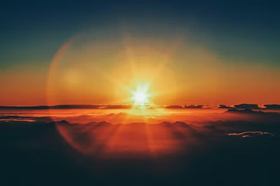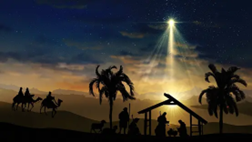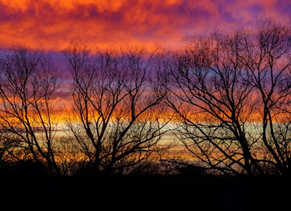by Rev. Racquel Ray
Associate Minister of Congregational Life
I enjoy marking the dwindling daylight of December days. I observe the sunrise and sunset times and the low angles of sunrays that beam through the southern windows. My afternoon walks are hastened by the chill of shortened days. These are the shortest days of sunshine and longest nights of darkness in our region. These are the days of Advent and lights, soup and hot tea, a turnover in the church liturgical calendar year. There is a shift in the sanctuary; the lectionary resets and altar colors change from green to blue. Something is different. Something is coming.
There is a pair of kingfishers, halcyon birds, that come and visit our backyard each December at this time. The spring-fed freshwater pond used to be the local ice-skating spot in years gone by. The kingfishers dart and whistle breaking the golden sparkling stillness of the afternoon. They swoop to the water and back to the trees upsetting the backyard rhythm of blue jays and sparrows. They too are different.
backyard each December at this time. The spring-fed freshwater pond used to be the local ice-skating spot in years gone by. The kingfishers dart and whistle breaking the golden sparkling stillness of the afternoon. They swoop to the water and back to the trees upsetting the backyard rhythm of blue jays and sparrows. They too are different.
There is a legend of the halcyon birds heralding days of calm free from storms and tempests. And in the case of my backyard during Advent, halcyon days are the days around the winter solstice and Christmas. When the kingfishers visit, the days are their shortest, darkest, and the calmest of the year. The first and second candles of the Advent wreath on my dining room table and on our church altar are getting short as well.
 And then there is a shift. In these days, the morning sunrise is minutes later but the afternoons have shifted. One minute at a time, the afternoons are lengthening. The mornings won’t catch up until January. But, there is hope in the extended afternoon. Hope that the sunshine is returning, and a “light is breaking forth” as the prophet Isaiah proclaimed.
And then there is a shift. In these days, the morning sunrise is minutes later but the afternoons have shifted. One minute at a time, the afternoons are lengthening. The mornings won’t catch up until January. But, there is hope in the extended afternoon. Hope that the sunshine is returning, and a “light is breaking forth” as the prophet Isaiah proclaimed.
These same days are wrapped in Christmas preparations. Our packages and Christmas cards are sent to loved ones, friends, colleagues, and congregation members. The Christmas pageant plans are taking shape; script, sheep and shepherds, angels and archangels, manger and magi, Joseph and Mary are ready. We send our end of year gifts and pledges. We volunteer, we share meals, we donate winter coats and mittens. We bring flowers to the cemetery and lay wreaths for remembered veterans. We wait in expectation for the light to break forth in the Nativity as well.
Christmas pageant plans are taking shape; script, sheep and shepherds, angels and archangels, manger and magi, Joseph and Mary are ready. We send our end of year gifts and pledges. We volunteer, we share meals, we donate winter coats and mittens. We bring flowers to the cemetery and lay wreaths for remembered veterans. We wait in expectation for the light to break forth in the Nativity as well.
Isaiah prophesies, “Is this not the fast that I chose: to loose the bonds of injustice, to undo the thongs of the yoke, to let the oppressed go free, and to break every yoke: Is it not to share your bread with the hungry, and bring the homeless poor into your house; when you see the naked, to cover them, and not to hide yourself from your own kin? Then your light shall break forth like the dawn, and your  healing shall spring up quickly, your vindicator shall go before you, the glory of the Lord shall be your rear guard. Then you shall call, and the Lord will answer; you shall cry for help, and he will say, Here I am.”[1]
healing shall spring up quickly, your vindicator shall go before you, the glory of the Lord shall be your rear guard. Then you shall call, and the Lord will answer; you shall cry for help, and he will say, Here I am.”[1]
At Christmastime, we are quick to offer peace to our neighbors, provision to the poor, hats to the homeless, and hospitality to our families. Do we receive the connection between Isaiah’s message and Jesus’ mission to feed, clothe, shelter the least of these among us? The Light that breaks forth in these halcyon days is not merely the sun. The Son, the promised, long-expected Jesus is breaking open the heavens and the virgin womb, connecting creator and creature, lifting creation and cosmos.
connecting creator and creature, lifting creation and cosmos.
And, in the dwindling darkest days that envelop us, can we observe and deeply receive the hope that Light is merely a breath away? An afternoon walk, an inhale and exhale, a candle, a card, a package, a present, a wink and a nod, are all just an awareness awakening to the growing Light in our darkness. And one minute at a time, one person at a time, may we each call upon the Lord and so readily receive Him as we receive the sunshine of lengthening days.
[1] (Coogan, Brettler, Newsom, & Perkins, 2010) Isaiah 58:6-9



